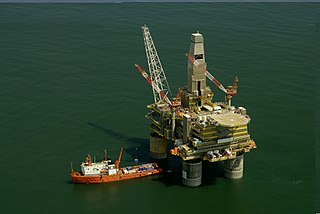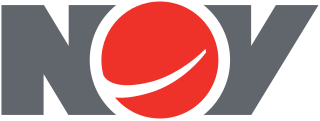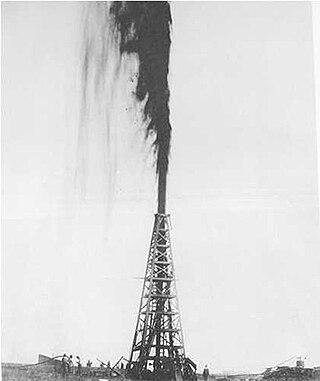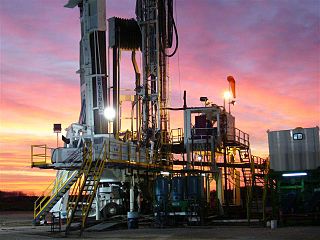
Louisiana Story is a 1948 American black-and-white drama film directed and produced by Robert J. Flaherty. Its script was written by Frances H. Flaherty and Robert J. Flaherty. Although it has historically been represented as a documentary film, the events and characters depicted are fictional. There is not enough factual or educational material in the film to warrant classifying it as docufiction. The film was commissioned by the Standard Oil Company to promote its drilling ventures in the Louisiana bayous.

An oil platform is a large structure with facilities to extract and process petroleum and natural gas that lie in rock formations beneath the seabed. Many oil platforms will also have facilities to accommodate the workers, although it is also common to have a separate accommodation platform linked by bridge to the production platform. Most commonly, oil platforms engage in activities on the continental shelf, though they can also be used in lakes, inshore waters, and inland seas. Depending on the circumstances, the platform may be fixed to the ocean floor, consist of an artificial island, or float. In some arrangements the main facility may have storage facilities for the processed oil. Remote subsea wells may also be connected to a platform by flow lines and by umbilical connections. These sub-sea facilities may include one or more subsea wells or manifold centres for multiple wells.

A drilling rig is an integrated system that drills wells, such as oil or water wells, or holes for piling and other construction purposes, into the earth's subsurface. Drilling rigs can be massive structures housing equipment used to drill water wells, oil wells, or natural gas extraction wells, or they can be small enough to be moved manually by one person and such are called augers. Drilling rigs can sample subsurface mineral deposits, test rock, soil and groundwater physical properties, and also can be used to install sub-surface fabrications, such as underground utilities, instrumentation, tunnels or wells. Drilling rigs can be mobile equipment mounted on trucks, tracks or trailers, or more permanent land or marine-based structures. The term "rig" therefore generally refers to the complex equipment that is used to penetrate the surface of the Earth's crust.
A mud engineer works on an oil well or gas well drilling rig, and is responsible for ensuring the properties of the drilling fluid, also known as drilling mud, are within designed specifications.

NOV Inc., formerly National Oilwell Varco, is an American multinational corporation based in Houston, Texas. It is a worldwide provider of equipment and components used in oil and gas drilling and production operations, oilfield services, and supply chain integration services to the upstream oil and gas industry. The company conducts operations in more than 500 locations across six continents, operating through two reporting segments: Energy Equipment and Energy Products and Services.

In geotechnical engineering, drilling fluid, also known as drilling mud, is used to aid the drilling of boreholes into the earth. Used while drilling oil and natural gas wells and on exploration drilling rigs, drilling fluids are also used for much simpler boreholes, such as water wells.

Roustabout is an occupational term. Traditionally, it referred to a worker with broad-based, non-specific skills. In particular, it was used to describe show or circus workers who handled materials for construction on fairgrounds. In modern times it is applied to rural employment, such as those assisting sheep shearing, and positions in the oil industry.

A blowout is the uncontrolled release of crude oil and/or natural gas from an oil well or gas well after pressure control systems have failed. Modern wells have blowout preventers intended to prevent such an occurrence. An accidental spark during a blowout can lead to a catastrophic oil or gas fire.

A derrickhand or derrickman is the person who sits atop the derrick on a drilling rig. Though the exact duties vary from rig to rig, they almost always report directly to the driller. Their job is to guide the stands of the drill pipe into the fingers at the top of the derrick. Other duties might include monitoring pH and calcium levels, viscosity and the mud weight (density), adding chemicals and oil based fluids, and being responsible for the shale shakers and mud pump.

The drill floor is the heart of any drilling rig. This is the area where the drill string begins its trip into the earth. It is traditionally where joints of pipe are assembled, as well as the BHA, drilling bit, and various other tools. This is the primary work location for roughnecks and the driller. The drill floor is located directly under the derrick.

A blowout preventer (BOP) is a specialized valve or similar mechanical device, used to seal, control and monitor oil and gas wells to prevent blowouts, the uncontrolled release of crude oil or natural gas from a well. They are usually installed in stacks of other valves.
A tool pusher is an occupation within the oil drilling industry.

The Driller is a team leader in charge during the process of well drilling. The term is commonly used in the context of an oil well drilling rig. Driller comes after the Toolpusher in the Rig crew hierarchy. Toolpusher takes the operation orders from the Company-man. Toolpusher then supervises these order to the driller and the rest of the drilling crew and gets the job done. While Toolpusher, driller and the drilling crew generally belong to the Drilling contractor company, Company-man is the employee of the operator company.

Petroleum is a fossil fuel that can be drawn from beneath the Earth's surface. Reservoirs of petroleum are formed through the mixture of plants, algae, and sediments in shallow seas under high pressure. Petroleum is mostly recovered from oil drilling. Seismic surveys and other methods are used to locate oil reservoirs. Oil rigs and oil platforms are used to drill long holes into the earth to create an oil well and extract petroleum. After extraction, oil is refined to make gasoline and other products such as tires and refrigerators. Extraction of petroleum can be dangerous and have led to oil spills.
Oilfield terminology refers to the jargon used by those working in fields within and related to the upstream segment of the petroleum industry. It includes words and phrases describing professions, equipment, and procedures specific to the industry. It may also include slang terms used by oilfield workers to describe the same.
A service rig is a mobile platform loaded with oil industry service equipment that can be driven long distances within the oil fields to service wells. Unlike drilling rigs, service rigs return to a particular well many times.

FC Tulsa is an American professional soccer team based in Tulsa, Oklahoma which competes in the USL Championship, the second tier of the American soccer pyramid.
An iron roughneck is a piece of hydraulic machinery used to "handle" segments of pipe in a modern drilling rig. The segments can be manipulated as they are hoisted into and out of a borehole. This type of work was previously performed manually by workers using tongs, and was one of the most dangerous jobs in a drilling operation. However, with iron roughnecks and modern technology, much of this can be done remotely with minimal manual handling.













